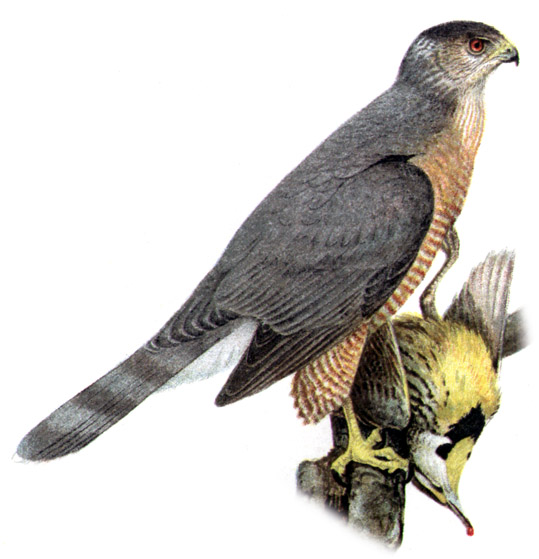Mike Breiding's Epic Road Trips ~2018~
Birds and Bats and Lizards - Oh My!!
Fun with our Animal Freinds
The Sonoran Desert
November 2018: Trailer Park Wildlife
When we first started spending the winters at our place in Tucson one of the first things we did was begin feeding the birds. Since many of the birds here are ground feeders we picked up a bag of generic mixed seed and simply cast some on the ground. It wasn't long before we had birds flying into and hopping all around our little side yard and border hedges.

Where the birds are.
I also fling seed up into the arborvitae hedge which borders our lot on the west side. The east side has a clump of arbs as well. The arborvitae was planted who knows when and is now about 20-25' tall. The birds love it as it provides good cover for them when they are waiting for the other birds to get their fill of our cheap feed.
When the seed falls through the arborvitae branches and foliage most lands on the ground but some of the seeds lodge in the smaller twigs and the foliage of the arborvitae. When this happens the birds will be all over the hedge gleaning the seeds that are lodged in the stems and foliage which allows us a better look at them.
Here is a photo sampler of some of the birds we see in our "yard". It gets better every year!
Far and away our most common visitor is the mourning dove. Every morning when they arrive they are so thick on the ground it looks like a bunch of ants crawling about. I have no doubt they eat the lion's share of the feed.
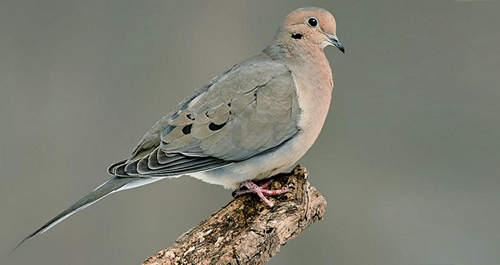
The mourning dove is the most common bird in our yard at feeding time. The year round range of mourning doves covers every state in the lower 48 except for North Dakota. The breeding range cover all 48 states and most of Mexico and the Caribbean. A testament to the birds adaptability.
Photo: AllAboutBirds.org
Image: WikiPedia
Fortunately we have plenty of Coopers Hawks in the neighborhood to help keep the dove population in check. On a regular basis we find piles of dove feathers where once there was a dove enjoying its breakfast.
One day while we were enjoying our Happy Hour on the front porch we were fortunate to have a Coopers take a dove from the feeding area. It then flew across the street, alighted on a fence and we watched it picking the dove to pieces as we enjoyed our beverages.
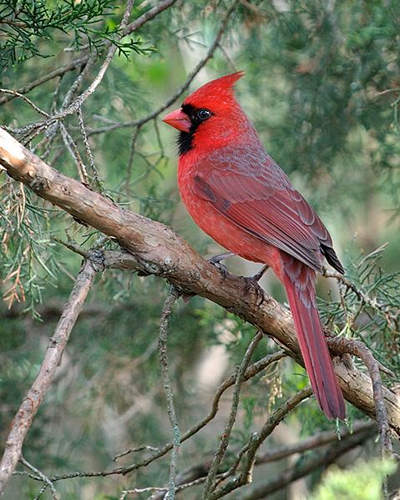
We were so happy to see the cardinals! It makes Tucson seem a little bit more like home. They are regulars and always go for the sunflower seeds first.
Photo: WikiPedia

Meet the Pyrrhuloxia. At first glance it is often confused with the Cardinal but the combination of grey coloration and punk hair-doo make it quite distinct.
Photo: AllAboutBirds.org
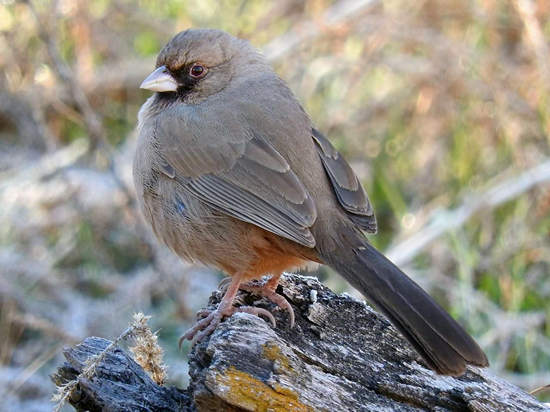
Here is the Abert's Towhee, a western counterpart to our beloved rufous-sided towhee of the east. It is often hard to spot as it stays back in the thicker parts of the hedge as it feeds. We often hear the Abert's Towhee rather than see him as the "simple series of sweet, ringing, staccato peep call notes" come forth from the hedge.
Photo: AllAboutBirds.com
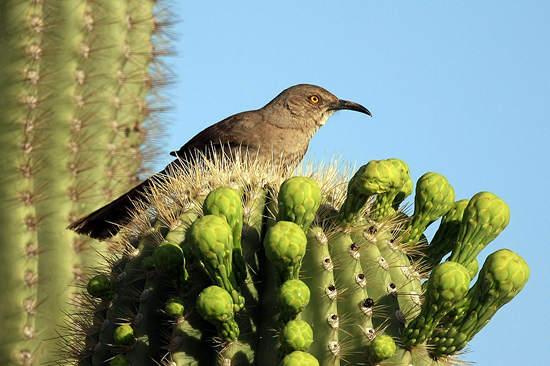
This robin sized grey bird is unmistakable by its long curved bill and penetrating black eye which has an orange ring. The curved bill is handy for digging out seeds from the fruit of cacti such as Barrel cactus.
Photo: WikiPedia

We became well acquainted with the white-crowned sparrow song at our feeding station in Morgantown, West Virginia. It was always a delight to hear their sweet song during the somber days of winter.
Photo: WikiPedia
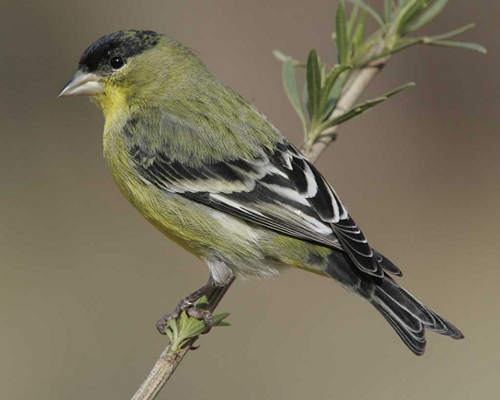
The goldfinch we see here in Tucson Estates, the Lesser goldfinch, is noticeably smaller than the one we have in the east. But the flight patterns are similar with undulating short straight stretches of flight with dips in between.
"The complicated song of the male usually includes short imitations of the voices of other birds."
Photo: audubon.org
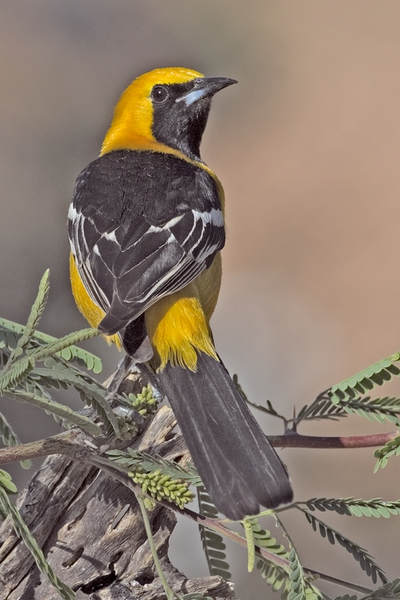
This is the Hooded Oriole and was a bird we did not expect to see. But it turns out they feed on the flowers of the aloe plant and we have plenty of them here at 5472.
Photo: WikiPedia
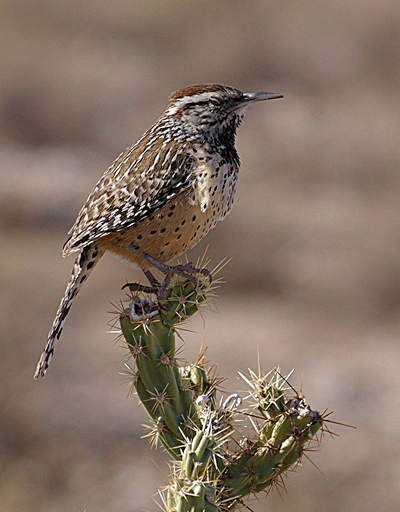
The cactus wren is the largest wren in North America. Like most wrens it moves about nervously and makes all manner of interesting sounds. This along with the curved-billed thrasher are almost always seen on our desert hikes.
Two other wrens we see/hear when hiking are the Canyon and Rock Wrens.
Photo: WikiPedia
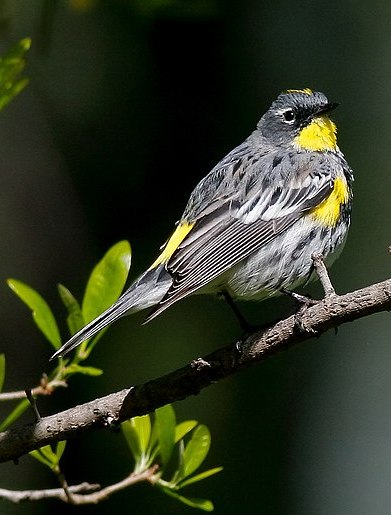
Another recent arrival at our feeding station is the gorgeous Yellow-Rumped/Audubon's warbler.
"The yellow-rumped warbler (Setophaga coronata) is a North American bird species combining four closely related forms: the eastern myrtle warbler (ssp coronata); its western counterpart, Audubon's warbler (ssp group auduboni); the northwest Mexican black-fronted warbler (ssp nigrifrons); and the Guatemalan Goldman's warbler (ssp goldmani)".
Photo: WikiPedia
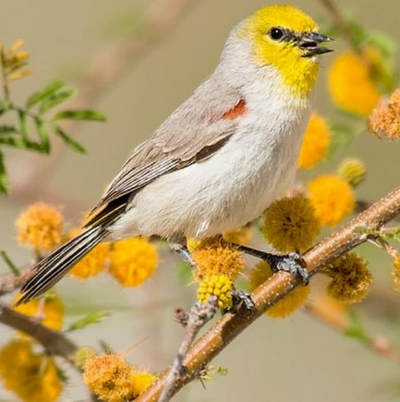
This colorful little bird is one of our most common both in the yard and out on our desert walks.
Photo: Susan Schalbe - AllAboutBirds.org
A tiny, active songbird of the arid southwestern United States and northern Mexico, the Verdin is the only North American member of the penduline-tit family (Remizidae). Vocal and often conspicuous despite its size, it builds a large enclosed nest in thorny scrub.
Source: www.AllAboutBirds.org
Last but not least is the Road Runner. Although they are infrequent visitors to our yard, we regularly see them running across the road (imagine that!) and along the open areas of The Loop bicycle path.
While I fling seed Betsy cooks up the hummingbird food. Yep, we finally have hummingbirds at a feeder. Where we lived in West Virginia we never seemed to be able to get them to come in to the feeder. It sure is different here in Tucson! The hummer activity is constant throughout the day.
Here are the two critters we have whizzing around the porch all day.
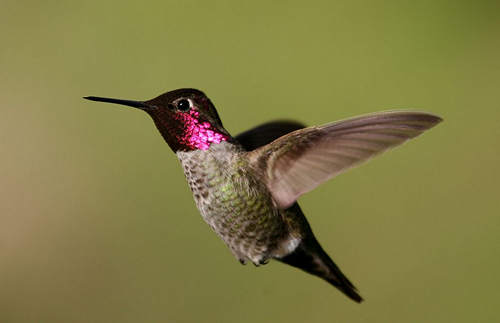
By far the most frequent visitor to our feeder is the Anna's hummingbird. Like most hummingbirds they are very territorial and aggressively chase off rivals who might want a sip or two of the sugar water.
Photo: WikiPedia
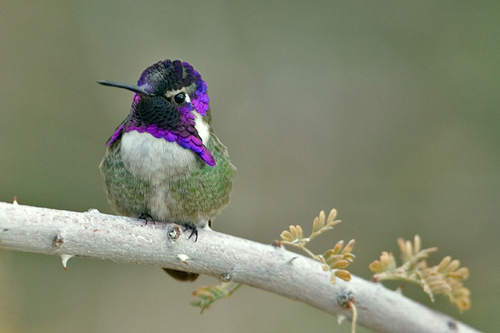
This little beauty - the Costa's hummingbird is new to our feeder this year and has stayed all winter. The Anna's seems a giant compared to this little cutie and we have really enjoyed having it around.
Photo: WikiPedia
This past October when my mom and I went on a road trip to San Francisco something unusual occurred at our feeding station. Below is Betsy's account of that occurrence.
When Mike and I arrive in Tucson each fall we are quick to hang up the hummingbird feeder on our porch. We don't get droves of hummers, but we get enough of them to keep us entertained. This past fall was no different except that soon after we hung the feeder we departed Tucson again - Mike on a road trip to California and my sister and I to Cottonwood, AZ to enjoy the sights and some cooler temperatures.
On October 12, Char and I returned from our Cottonwood trip to find our porch hummingbird feeder entirely empty. This puzzled me! We had been gone only five days and the hummers had never drained the feeder in such a short time. Did we for some reason have a bumper crop of the little creatures this year, drinking up our syrup and wondering why we hadn't put out more? I filled the feeder again and hung it up that evening.
In the morning the feeder was empty. Hmmmm. There was no sign that it had been tipped. What was going on?
So I did what anyone does when she needs an answer - I Googled it. And sure enough I found that other people in our area had the same mysterious circumstances going on. And the culprit was most probably - bats! Yes, nectar drinking bats visit the desert to pollinate the cacti and those bats are not adverse to drinking out of the red cactus flowers we call hummingbird feeders. Two species of bats were suggested in the internet information: the Mexican long tongued bat and the Lesser long nosed bat both of which spend the summer in our area before returning to Mexico. The information indicated the Lesser long nosed bat had just been removed from the endangered species list.
By this time Mike had also returned from his travels and he remembered our friend Esther had a wildlife cam. If we borrowed it and set it up on the porch, perhaps we could know for sure who was visiting us in the night. The camera indeed recorded bats! We couldn't see them in detail, not enough to know what kind they were, but we could definitely see them swooping and fluttering around the feeder.
We thought it was pretty cool to have bats coming to our bird feeder and decided to continue to feed them as long as they continued to visit. At some point I discovered bat information on a US Fish and Wildlife site and decided to get in touch with them about our new pets. I got an immediate reply from Scott Richardson at the Tucson Office and a request to come to our place to gather bat data by netting them, recording information and releasing them again to go on their way.
So on October 29th, three folks from Fish and Wildlife arrived around dusk and began setting up their nets around the porch. They told us we were welcome to sit quietly in the dark with them while they waited for the bats to arrive. It wasn't too long before we saw a shape flutter through the porch but it was not immediately caught in the nets. There were several times we were sure a bat had been netted but none was found. Finally one of the little creatures flew into a net and was trapped.
The experts retrieved it right away, placed it in a small bag and brought it back to the porch where they had their equipment. On examination, they determined it to be a female first year lesser long nosed bat. They then passed it over a special light to check whether it had ever been tagged before, but it had not. After being tagged, the bat was released.
I asked Scott, who was handling the bat, whether he was concerned about rabies and he told me he had had his rabies shots, however Lesser long nosed bats are not a target species for rabies. Neither is the bat disease White nose syndrome presently a threat to them as they are migrating rather than hibernating bats.
While Scott was handling the bat Mike took a couple of photos.After the first bat netting, we sat quietly in anticipation until 9:00 but did not net another bat. We saw them fly through the porch area several times but they did not appear to drink from the hummingbird feeder and did not fly into the nets.
Although we netted only one bat that evening, the netting did add valuable information to the study. Up until that night, only male bats had recently been netted in the Tucson Mountain area which was unusual because the normal capture was 90% female bats. Thus Fish and Wildlife had been wondering whether there were now only male bats in the western portion of the valley. Our netting proved that to be untrue.
In the following nights our feeder did not appear to have been visited. Apparently our bats had left on their migratory trip to Mexico. Scott indicated the bats had also abandoned the feeders at his house.
We hope to be hosts to our bat friends in the following years. We will have to wait and hope for the best. ~ Betsy
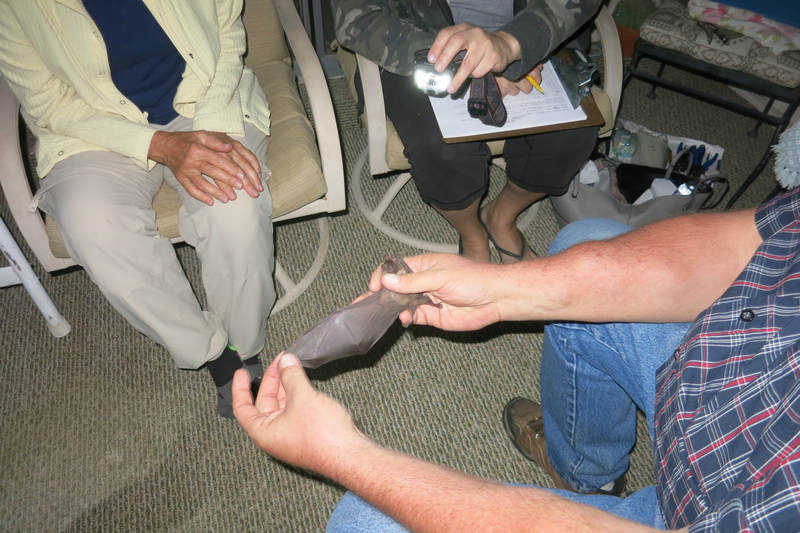
The wingspread of this Lesser long-nosed bat was quite impressive.
The lesser long-nosed bat (Leptonycteris yerbabuenae) is a medium-sized bat found in Central and North America. It is sometimes known as Sanborn's long-nosed bat or the Mexican long-nosed bat, though the latter name is better avoided since it is also used for the entire genus Leptonycteris and for one of the other species in it, the greater long-nosed bat (L. nivalis).
The tongue of lesser long-nosed bats has a number of adaptations for lapping nectar, including long ridges and rough, conical papillae, which may also help protect against periodontal disease by scraping the teeth clean. Their wings have a high wing loading, allowing for energy efficient long-distance flight in open habitats, at the expense of manoeuvrability.
Source: WikiPedia
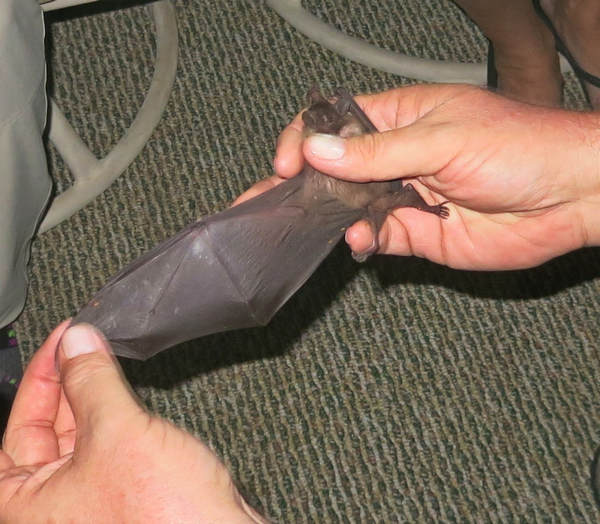
A closer look at the wings.
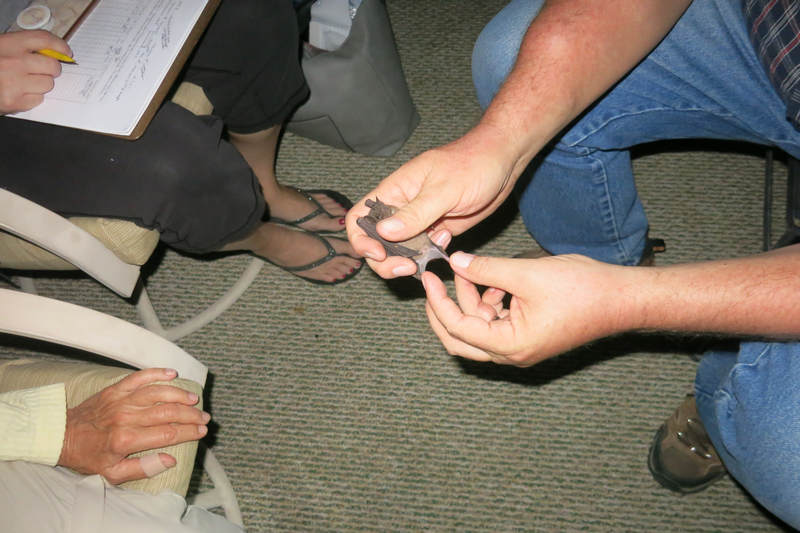
Here Scott explains how to tell a female Lesser long-nosed bat from a male.

Up close and personal.
Now that we have talked about the Birds and Bats, what about the Lizards?
There are about 20 species of lizards which inhabit the Sonoran desert and the canyons of the Sky Islands. We generally see lizards scampering about when we arrive back in Tucson in October. During winter months we see them only infrequently until the weather starts to warm back up in March.
This past October when Betsy and I hiked the Sutherland trail in Catalina State Park we came across a lizard I have wanted to see all my life.
As we were walking back to the car we passed through a wide open sunny area where the trail is the width of a roadway. When I hike I make it a habit to constantly scan in all directions. Why? Because you just never know what you might see.
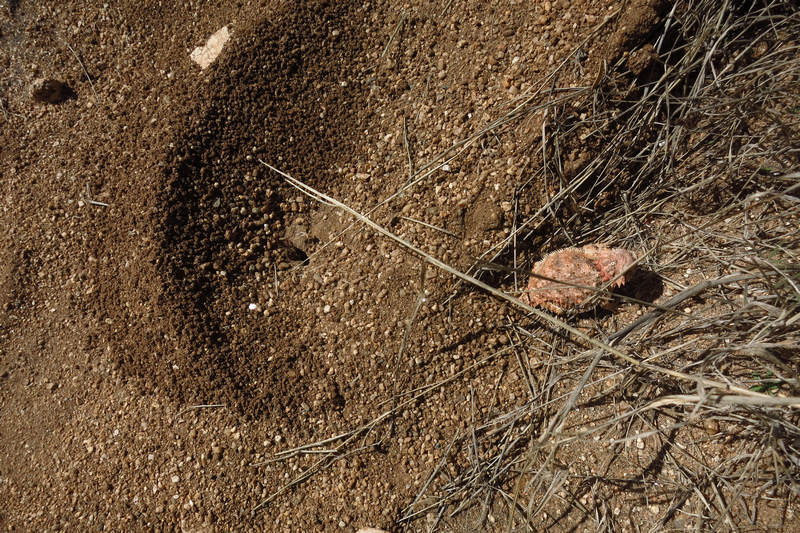
And here is what we saw that day - a "Horned lizard"!
I know what you are thinking - "Is that a lizard? It looks more like some kind of strange toad!" And indeed, when I was growing up people referred to these strange looking creatures as "Horney Toads". They were even collected in the wild and sold in some pet stores. And as you might expect that took its toll on native populations.
Texas horned lizards were once so common that in the 1950s a small West Texas gas station paid local kids a nickel for each reptile they collected, and then gave one to each customer who bought a full tank of gas. On dusty farms and ranches and in ramshackle oil-field camps in parts of the Great Plains, children played with the six-inch lizards--once numbering in the thousands--as if they were backyard pets. Some residents remember hitching the reptiles to toy Matchbox wagons with harnesses of thread. One woman even recalls sewing dresses for them. Times have changed.
In Texas, horned lizards have disappeared from at least 30 percent of their historic range, mostly in the central and eastern portions, according to state biologists. The state protected the species as threatened in 1977, and both Texas and Oklahoma now prohibit collection. Yet the species still shows up in pet stores as far away as New Jersey.
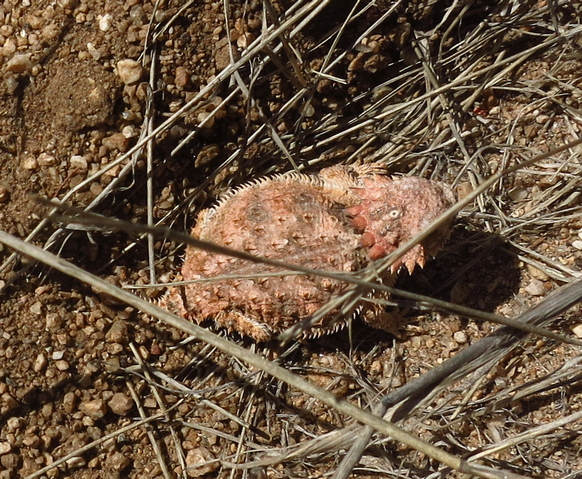
Once upon a time I did see one of these cuties, probably at the Brooks Nature Center where my dad was Naturalist. But this was my first time seeing one in the wild, Betsy's too.
This Greater short-horned lizard had been eating ants when I disturbed its lunch and it did an about face and was heading for a hiding place. Look closely at the first photo and you might be able to differentiate the soil particles from the ants - but I doubt it.
A bit more about horned lizards.
Horned lizards prefer to eat ants, but they will also eat many other types of invertebrates, such as grasshoppers, beetles and spiders, to supplement their diet. Usually, they search for prey in open areas, moving quietly searching or waiting for an unsuspecting ant or other food item to come into view. When a prey animal passes by, the lizard quickly snaps it up with a flick of its tongue and swallows it whole.
Horned lizards are called horny toads but really are not frogs or toads. They are reptiles - lizards. Like all reptiles, horned lizards depend primarily on their environment to control their body temperature - and they like it HOT! Most horned lizards live in desert or semi-arid environments. They are often seen basking in the morning sun on a summer day. Even so, they are susceptible to overheating, so as the day gets warmer, the lizards move into the shade and may even go into burrows to stay cool in the long summer afternoons.
Source: http://www.HornedLizards.org/
Well, there you have it "Birds and Bats and Lizards - Oh My!!"
Oh my indeed. The Sonoran Desert is quite the amazing place.
Until next time...
Mike and Betsy
